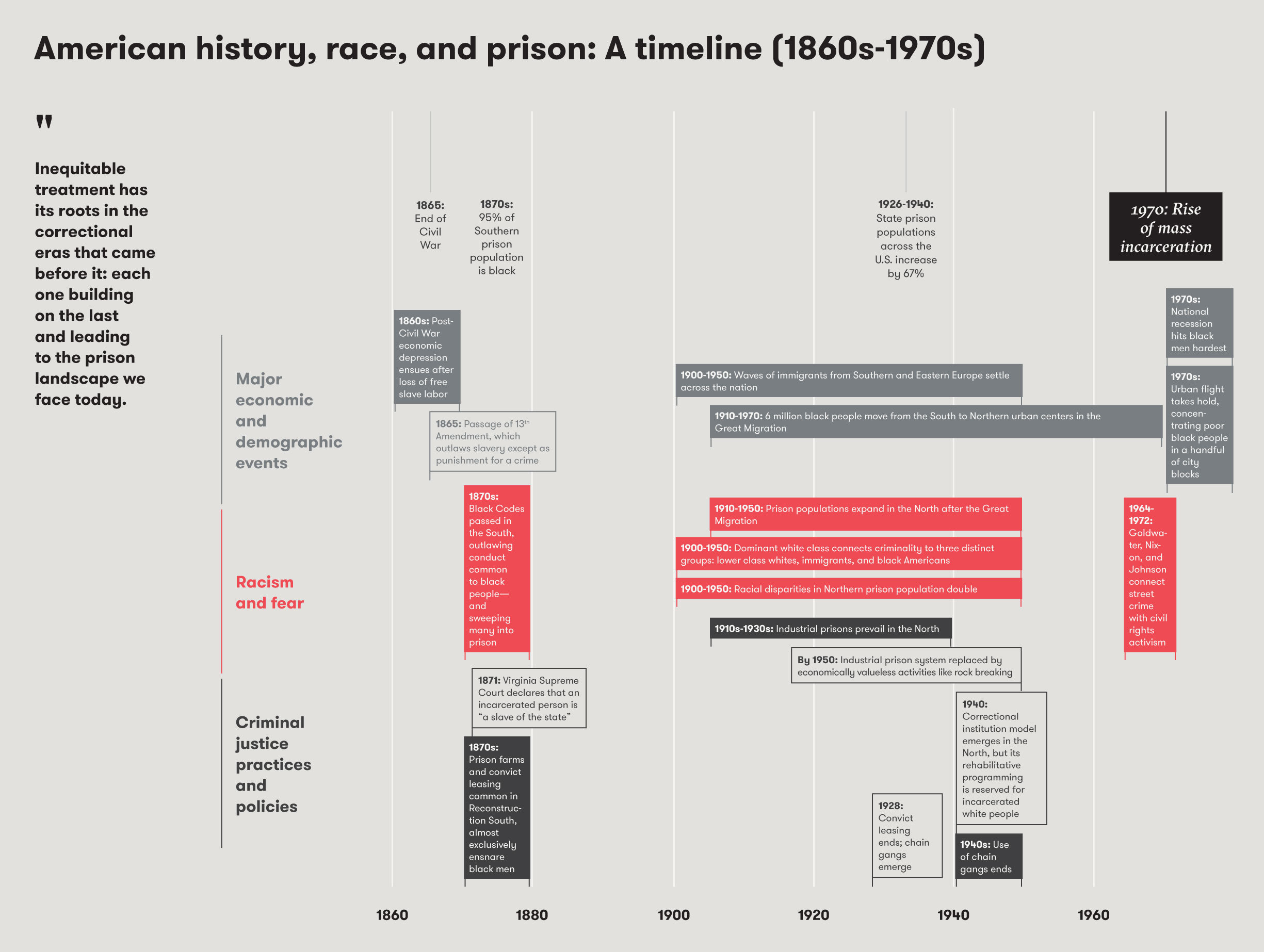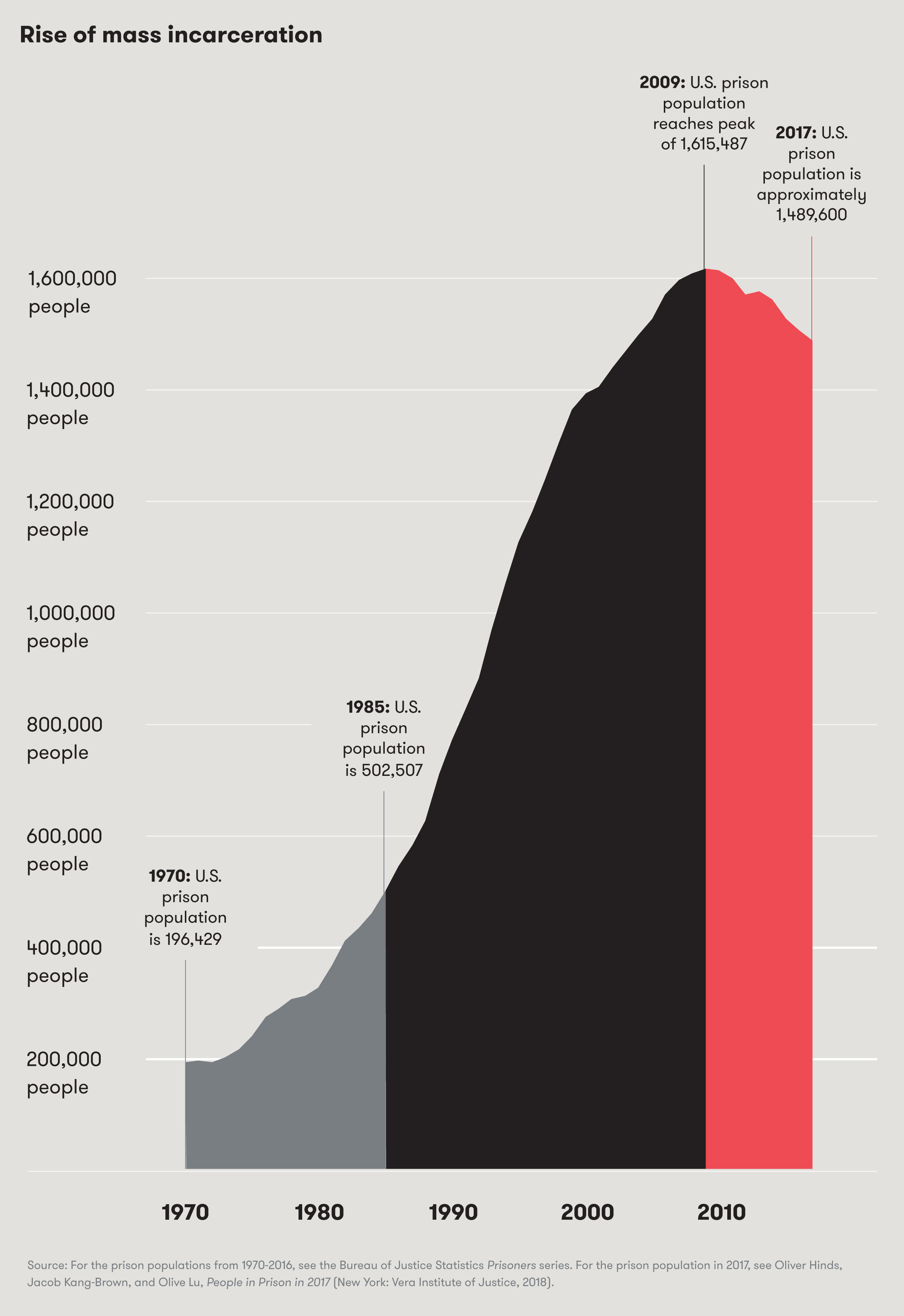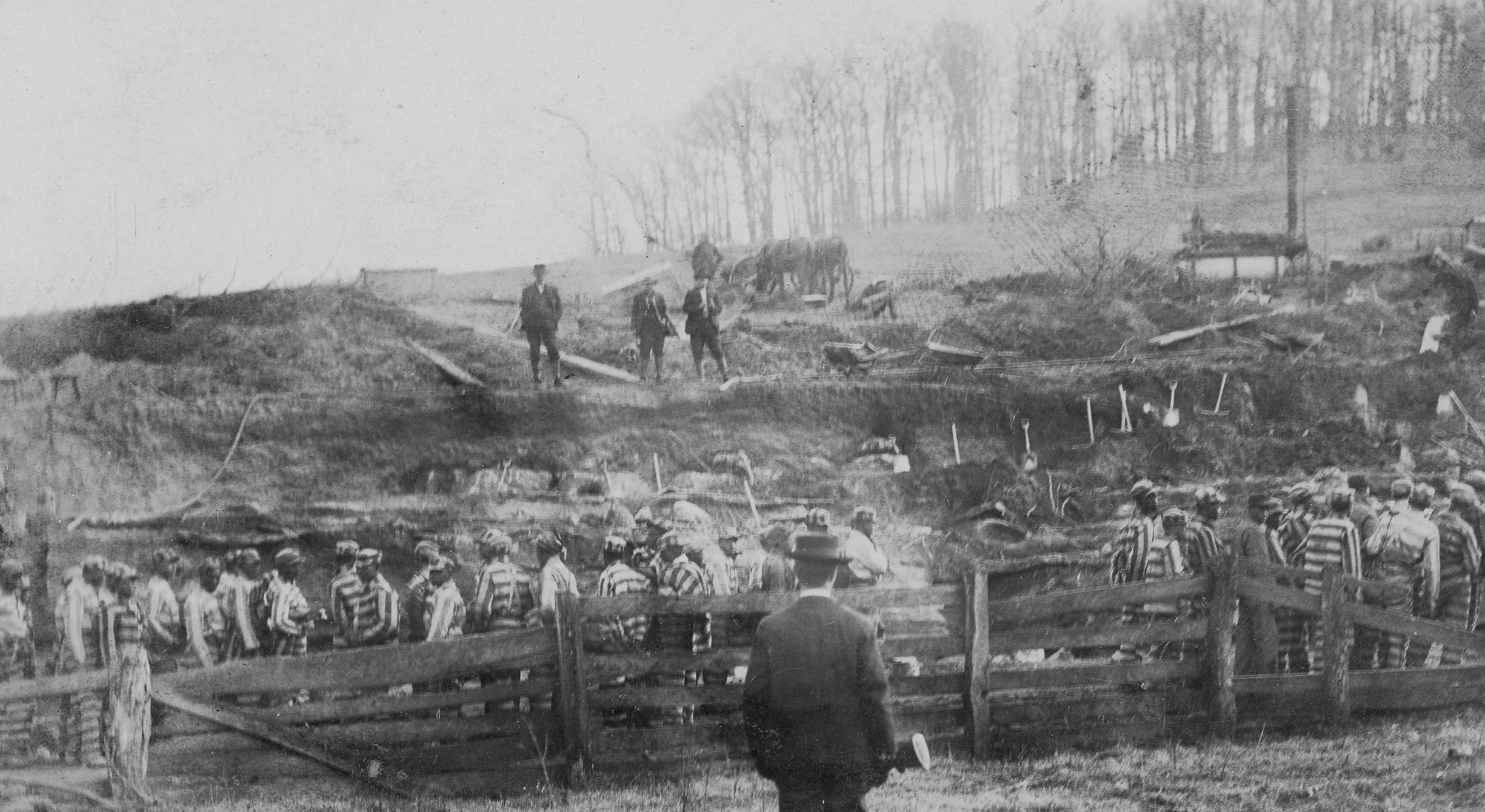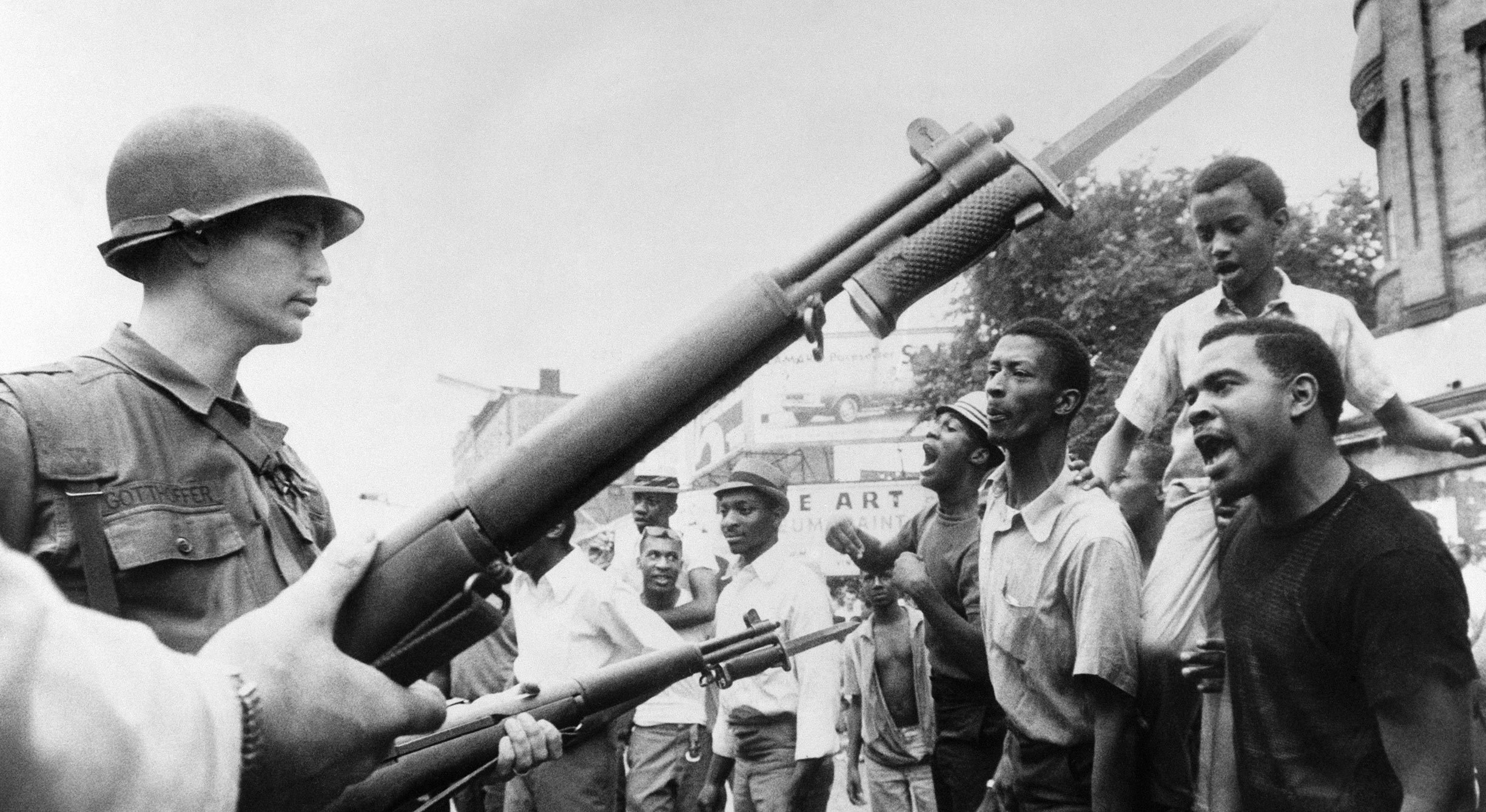“[In September 2016], on the 45th anniversary of the infamous Attica Prison uprising, tens of thousands of US inmates launched a nationwide protest. . . . The inmates’ grievances [were] as varied as the states they came from: Pennies for labor in South Carolina, racial discrimination in California, excessive force in Michigan. However, they share[d] an overarching goal: End legalized slavery inside American correctional facilities.”
~ Max Blau and Emanuella Grinberg, “Why US Inmates Launched a Nationwide Strike,” CNN, 2016Max Blau and Emanuella Grinberg, “Why US Inmates Launched a Nationwide Strike,” CNN, October 31, 2016, https://perma.cc/S65Q-PVYS.
In 1970, the era of mass incarceration began. This growth in the nation’s prison population was a deliberate policy. It was inflamed by campaign rhetoric that focused on an uptick in crime and orchestrated by people in power, including legislators who demanded stricter sentencing laws, state and local executives who ordered law enforcement officers to be tougher on crime, and prison administrators who were forced to house a growing population with limited resources.Travis, Western, and Redburn, The Growth of Incarceration, 2014, 104-29; and Bruce Western, “The Prison Boom and the Decline of American Citizenship,” Society 44, no. 5 (2007), 30-36, 31-32.
From America’s founding to the present, there are stories of crime waves or criminal behavior and then patterns of disproportionate imprisonment of those on the margins of society.
Although the unprecedented increase in prison populations during this period may seem like an aberration, the ground was fertile for this growth long before 1970. Certainly the number of people sent to prison was far greater during the era of mass incarceration than in any other time period, but the policies that fueled that growth stemmed from a familiar narrative: one involving public anxiety about both actual and alleged criminal behavior by racial and ethnic minorities and the use of state punishment to control them.
It is a narrative that repeats itself throughout this country’s history. From America’s founding to the present, there are stories of crime waves or criminal behavior and then patterns of disproportionate imprisonment of those on the margins of society: black people, immigrants, Native Americans, refugees, and others with outsider status. The result has been the persistent and disproportionate impact of incarceration on these groups. From 1850 to 1940, racial and ethnic minorities—including foreign-born and non-English speaking European immigrants— made up 40 to 50 percent of the prison population.Margaret Cahalan, “Trends in Incarceration in the United States Since 1880: A Summary of Reported Rates and the Distribution of Offenses,” Crime & Delinquency 25, no. 1 (1979), 9-41, 40. Note that over time, the ethnic and racial origins of interest to those collecting information on prison demographics have changed. Into the early decades of the 20th century, these figures included counts of those who were “foreign born.” More recent demographic categories have included white, black, and Latino/Hispanic populations. In 2015, about 55 percent of people imprisoned in federal or state prisons were black or Latino.Carson and Anderson, Prisoners in 2015, 2016, 14.
It is a narrative founded on myths, lies, and stereotypes about people of color, and to truly reform prison practices—and to justify the path this report marks out—it is a narrative that must be reckoned with and subverted. We must grapple with the ways in which prisons in this country are entwined with the legacy of slavery and generations of racial and social injustice. No new era is built from a clean slate, but rather each is layered on top of earlier practices, values, and physical infrastructure. Mass incarceration is an era marked by significant encroachment on the freedoms of racial and ethnic minorities, most notably black Americans. But this inequitable treatment has its roots in the correctional eras that came before it: each one building on the last and leading to the prison landscape we face today. This section ties together this country’s history of racism with its history of incarceration and recounts three important junctures in the history of prisons through the lens of America’s troubled and complex history of racial oppression.
Inequitable treatment has its roots in the correctional eras that came before it: each one building on the last and leading to the prison landscape we face today.


Prison in the South: 1865-1940
“The history of Mississippi State Penitentiary is a history of failed reforms. Its creation in 1901 was borne of a statewide shame and frustration at the contemporary system of convict leasing. . . . Under convict leasing, the inmates were essentially slaves again. . . . They worked long hours for no pay, were poorly fed, and slept in tents at work sites doing dangerous jobs like dynamiting tunnels for railroad companies and clearing malaria-filled swamps for construction. Convicts, sometimes including children under age 10, were whipped and beaten, underfed, and rarely given medical treatment. . . .
Parchman [Farm]’s first year of operation was in 1905. It was massive, remote, and modeled after a traditional southern plantation. Parchman was originally comprised of three separate farms: a small farm, which was maintained by white convicts, a smaller one farmed by women (mostly black), and a huge sprawling plantation for the prison’s black convicts. Over 20,000 acres and 46 miles, it was intended to be self-sufficient and profitable for the state, and it was.
Parchman Farm stayed this way, more or less, for the next 70 years. Cotton picking became mechanized and the state instituted some small reforms. . . . [But the] small vocational and educational programs excluded black prisoners. A maximum security unit with a guard tower, fences, and gates housed individual cells, a gas chamber for executions, and a solitary confinement wing. Otherwise, Parchman remained frozen in time, a segregated, harsh prison farm.”
~ Hannah Grabenstein, “Inside Mississippi’s Notorious Parchman Prison,” PBS NewsHour, 2018Hannah Grabenstein, “Inside Mississippi’s Notorious Parchman Prison,” PBS NewsHour, January 29, 2018 (referencing David M. Oshinsky, Worse than Slavery: Parchman Farm and the Ordeal of Jim Crow Justice (New York: Free Press, 1997)), http://perma.cc/Y9A9-2E2F.
The year 1865 should be as notable to criminologists as is the year 1970. While it marked the end of the Civil War and the passage of the 13th Amendment, it also triggered the nation’s first prison boom when the number of black Americans arrested and incarcerated surged.Christopher R. Adamson, “Punishment After Slavery: Southern State Penal Systems, 1865-1890,” Social Problems 30, no. 5 (1983), 555-69; Khalil Gibran Muhammad, “Where Did All the White Criminals Go? Reconfiguring Race and Crime on the Road to Mass Incarceration,” Souls 13, no. 1 (2011), 72-90; and Western, “The Prison Boom,” 2007, 30-36. This was the result of state governments reacting to two powerful social forces: first, public anxiety and fear about crime stemming from newly freed black Americans; and second, economic depression resulting from the war and the loss of a free supply of labor. State and local leaders in the South used the criminal justice system to both pacify the public’s fear and bolster the depressed economy. All across the South, Black Codes were passed that outlawed behaviors common to black people, such as “walking without a purpose” or “walking at night,” hunting on Sundays, or settling on public or private land.

These laws also stripped formerly incarcerated people of their citizenship rights long after their sentences were completed. Among the most well-known examples are laws that temporarily or permanently suspended the right to vote of people convicted of felonies. Adamson, “Punishment After Slavery,” 1983, 558-59; A. E. Raza, “Legacies of the Racialization of Incarceration: From Convict-Lease to the Prison Industrial Complex,” Journal of the Institute of Justice and International Studies 11 (2011), 159-70, 162-65; Christopher Uggen, Jeff Manza, and Melissa Thompson, “Citizenship, Democracy, and the Civic Reintegration of Criminal Offenders,” ANNALS of the American Academy of Political and Social Sciences 605, no. 1 (2006), 281-310; and Elizabeth Hull, The Disenfranchisement of Ex-Felons (Philadelphia, PA: Temple University Press, 2006), 17-22.[/footnote] Southern law enforcement authorities targeted black people and aggressively enforced these laws, and funneled greater numbers of them into the state punishment systems. By the 1870s, almost all of the people under criminal custody of the Southern states—a full 95 percent—were black.This ratio did not change much in the following decades. In 1908 in Georgia, 90 percent of people in state custody during an investigation of the convict leasing system were black. For 1870, see Adamson, “Punishment After Slavery,” 1983, 558-61. For 1908, see Alex Lichtenstein, “Good Roads and Chain Gangs in the Progressive South: 'The Negro Convict is a Slave,'” Journal of Southern History 59, no. 1 (1993), 85-110, 90.
State penal authorities deployed these imprisoned people to help rebuild the South—they rented out convicted people to private companies through a system of convict leasing and put incarcerated individuals to work on, for example, prison farms to produce agricultural products.Adamson, “Punishment After Slavery,” 1983; Gwen Smith Ingley, “Inmate Labor: Yesterday, Today and Tomorrow,” Corrections Today 58, no. 1 (1996), 28-77, 30; Theresa R. Jach, “Reform Versus Reality in the Progressive Era Texas Prison,” Journal of the Gilded Age and Progressive Era 4, no. 1 (2005), 53-67; and Robert Johnson, Ania Dobrzanska, and Seri Palla, “The American Prison in Historical Perspective: Race, Gender, and Adjustment,” in Prisons Today and Tomorrow, edited by Ashley G. Blackburn, Shannon K. Fowler, and Joycelyn M. Pollock (Burlington, MA: Jones & Bartlett Learning, 2005), 22-42, 29-31. In the Reconstruction South, these were fiscally attractive strategies given the destruction of Southern prisons during the Civil War and the economic depression that followed it.In terms of prison infrastructure, it is also important to note that even before 1865, Southern states had few prisons. Another important consideration was that if a Southern state incarcerated a slave for a crime, it would be depriving the owner of the slave’s labor. Prisons in Southern states, therefore, were primarily used for white felons. The region depended heavily on extralegal systems to resolve legal disputes involving slaves and—in contrast to the North—defined white crime as arising from individual passion rather than social conditions or moral failings. Southern punishment ideology therefore tended more toward the retributive, while Northern ideology included ideals of reform and rehabilitation (although evidence suggests harsh prison operations routinely failed to support these ideals). Despite the differences between Northern and Southern ideas of crime, punishment, and reform, all Southern states had at least one large prison modeled on the Auburn Prison style congregate model by 1850. Adamson, “Punishment After Slavery,” 1983, 556-58; and Alexander Pisciotta, “Scientific Reform: The ‘New Penology’ at Elmira, 1876-1900,” Crime & Delinquency 29, no. 4 (1983), 613-30. Convict leasing programs that operated through an external supervision model—in which incarcerated people were supervised entirely by a private company that was paying the state for their labor—turned a state cost into a much-needed profit and enabled states to take penal custody of people without the need to build prisons in which to house them.Prior to the Civil War, prisons all over the country had experimented with strategies to profit off of the labor of incarcerated people, with most adopting factory-style contract work in which incarcerated people were used to perform work for outside companies at the prison. Between 1828 and 1833, Auburn Prison in New York earned $25,000 (the equivalent of over half a million dollars in 2017) above the costs of prison administration through the sale of goods produced by incarcerated workers. During the earliest period of convict leasing, most contracting companies were headquartered in Northern states and were actually compensated by the Southern states for taking the supervision of those in state criminal custody off their hands. Only in the 1870s and 1880s, after Southern-based companies and individuals retook control of state governments, did the arrangements reverse: companies began to compensate states for leasing convict labor. In some states, contracts from convict leasing accounted for 10 percent of the state’s revenues. Under convict leasing schemes, state prison systems in the South often did not know where those who were leased out were housed or whether they were living or dead. Private convict leasing was replaced by the chain gang, or labor on public works such as the building of roads, in the first decade of the 20th century in both Georgia and North Carolina. The chain gang continued into the 1940s. Those sentenced to serve on chain gangs were predominantly black. Adamson, “Punishment After Slavery,” 1983, 556, 562-66 & 567; Lichtenstein, “Good Roads and Chain Gangs,” 1993, 85-110; Matthew W. Meskell, “An American Resolution: The History of Prisons in the United States from 1777 to 1877,” Stanford Law Review 51, no. 4 (1999), 839-65, 861-62; and Raza, “Legacies of the Racialization of Incarceration,” 2011, 162-65.
Although economic, political, and industrial changes in the United States contributed to the end of private convict leasing in practice by 1928, other forms of slavery-like labor practices emerged.Matthew J. Mancini, "Race, Economics, and the Abandonment of Convict Leasing," Journal of Negro History 63, no. 4 (1978), 339-52; and J. A. C. Grant, “Interstate Traffic in Convict-Made Goods,” Journal of Criminal Law and Criminology 28, no. 6 (1938), 854-60, 855. State prison authorities introduced the chain gang, a brutal form of forced labor in which incarcerated people toiled on public works, such as building roads or clearing land. Chain gangs existed into the 1940s.Risa Goluboff, “The Thirteenth Amendment and the Lost Origins of Civil Rights,” Duke Law Journal 50, no. 6 (2001), 1609-85; and Lichtenstein, “Good Roads and Chain Gangs,” 1993, 85-110. And, as with convict leasing before it, those sentenced to serve on chain gangs were predominantly black.Adamson, “Punishment After Slavery,” 1983, 565-66; and Lichtenstein, “Good Roads and Chain Gangs,” 1993, 85-110. Prison farms also continued to dominate the Southern landscape during this period. In 1928, Texas was operating 12 state prison farms and nearly 100 percent of the workers on them were black.Jach, “Reform Versus Reality,” 2005, 57; and Johnson, Dobrzanska, and Palla, “Prison in Historical Perspective,” 2005, 27-29.
The loophole contained within the 13th Amendment, which abolished slavery and indentured servitude except as punishment for a crime, paved the way for Southern states to use convict leasing, prison farms, and chain gangs as legal means to continue white control over black people and to secure their labor at no or little cost.The language was selected for the 13th Amendment in part due to its legal strength. The concept had first entered federal law in Northwest Ordinance of 1787, which governed territories that later became the states of Indiana, Illinois, Michigan, Ohio, and Wisconsin. These states subsequently incorporated this aspect of the Northwest Ordinance into their state constitutions. Many other states followed suit. By the time the 13th Amendment was ratified by Congress, it had been tested by the courts and adopted into the constitutions of 23 of the 36 states in the nation and the Home Rule Charter of the District of Columbia. Eight Northeastern states (Connecticut, Massachusetts, New Hampshire, New Jersey, New York, Pennsylvania, Rhode Island, and Vermont) abolished slavery through a mixture of means and using various language by 1804. Maine entered the union as a free state in 1820. For more information about the congressional debate surrounding the adoption of the 13th Amendment, see David R. Upham, “The Understanding of ‘Neither Slavery Nor Involuntary Servitude Shall Exist’ Before the Thirteenth Amendment,” Georgetown Journal of Law & Public Policy 15, no. 1 (2017), 137-71; Arthur Zilversmit, The First Emancipation: The Abolition of Slavery in the North (Chicago: University of Chicago Press, 1967); and Matthew Mason, “The Maine and Missouri Crisis: Competing Priorities and Northern Slavery Politics in the Early Republic,” Journal of the Early Republic 33, no. 4 (2013), 675-700. Furthering control over black bodies was the continued use of extralegal punishment following emancipation, including brutal lynchings that were widely supported by state and local leaders and witnessed by large celebratory crowds. At least 4,000 such extra-judicial killings occurred between 1877 and 1950 in 20 states. Equal Justice Initiative, Lynching in America (2015). Very few white men and women were ever sent to work under these arrangements.Incarcerated whites were not included in convict leasing agreements, and few white people were sent to the chain gangs that followed convict leasing into the middle of the 20th century. Adamson, “Punishment After Slavery,” 1983, 565-66; Lichtenstein, “Good Roads and Chain Gangs,” 1993, 94 & 102; and Raza, “Legacies of the Racialization of Incarceration,” 2011, 162-65. By assigning black people to work in the fields and on government works, the state-sanctioned punishment of black people was visible to the public, while white punishment was obscured behind prison walls. By many accounts, conditions under the convict leasing system were harsher than they had been under slavery, as these private companies no longer had an ownership interest in the longevity of their laborers, who could be easily replaced at low cost by the state.Adamson, “Punishment After Slavery,” 1983, 562-66; and Raza, “Legacies of the Racialization of Incarceration,” 2011, 162-65. Although the incarcerated people subjected to this treatment sought redress from the courts, they found little relief.For a discussion of the narrow interpretation of the 13th, 14th, and 15th Amendments from 1865 to 1939 and the subsequent expansion of federal jurisdiction over exploitative work conditions as contrary to civil rights in the 1940s, see Goluboff, “The Thirteenth Amendment,” 2001, 1615 & 1637-44. Time and again, the courts approved of this abusive use of convict labor, confirming the Virginia Supreme Court’s declaration in 1871 that an incarcerated person was, in effect, a “slave of the state.”Prior to the 1960s, the prevailing view in the United States was that a person in prison “has, as a consequence of his crime, not only forfeited his liberty, but all his personal rights except those which the law in its humanity accords to him. He is for the time being the slave of the state.” Ruffin v. Commonwealth, 62 Va. 790, 796 (1871).
Prison in the North: 1920-1960
“At the dawn of the twentieth century, in a rapidly industrializing, urbanizing, and demographically shifting America, blackness was refashioned through crime statistics. . . . Northern black crime statistics and migration trends in the 1890s, 1900s, and 1910s were woven together into a cautionary tale about the exceptional threat black people posed to modern society. In the Windy City, in the City of Brotherly Love, and in the nation’s Capital of Commerce this tale was told, infused with symbolic references to American civilization, to American modernity, and to the fictive promised land of unending opportunity for all who, regardless of race or class or nationality, sought their fortunes.”
~ Khalil Gibran Muhammad, The Condemnation of Blackness: Race, Crime, and the Making of Modern Urban America, 2010Muhammad, The Condemnation of Blackness, 2010, 7.
The first half of the 20th century saw an expansion of prison populations in the Northern states, which coincided with shifting ideas about race and ethnicity, an influx of black Americans to urban regions in the North, and increased competition over limited jobs in Northern cities between newly arrived black Americans and European immigrants. As a backdrop to these changing demographics, public anxiety about crime flourished. A brief spike in violent crime in the 1920s was met with incendiary media coverage, highly publicized federal interventions into local crime, and the branding of certain suspected criminals as “public enemies,” stoking public fear and supporting criminal stereotypes.As crime was on the decline, the head of the Federal Bureau of Investigation, J. Edgar Hoover, began to characterize those who committed violent robberies as public enemies. Jeffrey Adler, “Less Crime, More Punishment: Violence, Race, and Criminal Justice in Early Twentieth-Century America,” Journal of American History 102, no. 1 (2015), 34-46, 41. The growing fear of crime—often directed at black Americans—intensified policing practices across the country and inspired the passage of a spate of mandatory sentencing policies, both of which contributed to a surge in incarceration.Policies establishing mandatory life sentences triggered by conviction of a fourth felony were passed first in New York in 1926 and, soon thereafter, in California, Kansas, Michigan, New Jersey, North Dakota, Oregon, South Dakota, and Vermont. Ibid.; and Muhammad, “Where Did All the White Criminals Go,” 2011, 79. Between 1926 and 1940, state prison populations across the country increased by 67 percent.The arrest rate among white people for robbery declined by 42 percent, while it increased by 23 percent among black people. For homicide, arrests declined by 8 percent for white people, but rose by 25 percent for black people. Adler, “Less Crime, More Punishment,” 2015, 44.
Between 1910 and 1970, over six million black Americans migrated from the South to Northern urban centers. Known as the Great Migration, this movement of people dramatically transformed the makeup of both the South and the North: in 1910, 90 percent of black Americans lived in the South but, by 1970, that number had dropped to 53 percent.Isabel Wilkerson, “The Long-Lasting Legacy of the Great Migration,” Smithsonian Magazine, September 2016, https://perma.cc/FZ32-V3SR. These migrants—typically more financially stable black Americans—were fleeing racial terror and economic exclusion.Up until World War I, European immigrants were not granted the full citizenship privileges that were reserved for fully “white” citizens. This social, political, and economic exclusion extended to second-generation immigrants as well. The Great Migration of more economically successful Southern black Americans into Northern cities inspired anxiety among European immigrant groups, who perceived migrants as threats to their access to jobs. Christopher Muller, “Northward Migration and the Rise of Racial Disparity in American Incarceration, 1880–1950,” American Journal of Sociology 118, no. 2 (2012), 281-326, 284 & 292-93. This influx of people overlapped with the waves of immigrants from Southern and Eastern Europe who continued to disembark and settle across the country throughout the first half of the 20th century. During this time period, the dominant white class connected criminality to three distinct groups: lower-class whites, immigrants, and black Americans.Muhammad, The Condemnation of Blackness, 2010, 74. However, while white and immigrant criminality was believed by social reformers to arise from social conditions that could be ameliorated through civic institutions, such as schools and prisons, black criminality was given a different explanation. Widely popular—but since discredited—theories of racial inferiority that were supported by newly developed “scientific” categorization schemes took hold.All black Americans were fully counted in the 1870 census for the first time and the publication of the data was eagerly anticipated by many. By the 1890 census, census methodology had been improved and a new focus on race and crime began to emerge as an important indicator to the status of black Americans after emancipation. Debates arose whether higher crime rates among black people in the urban North were biologically determined, culturally determined, or environmentally and economically determined. White crime was typically discussed as environmentally and economically driven at the time. These ideas were supported by widely held so-called “scientific” theories of genetic differences between racial groups, broadly termed eugenics. Other popular theories included phrenology, or the measurement of head size as a determinant of cognitive ability, and some applications of evolutionary theories that hypothesized that black people were at an earlier stage of evolution than whites. This group of theories, especially eugenic theories, were publicly touted by social reformers and prominent members of the social and political elite, including Theodore Roosevelt and Margaret Sanger. Muhammad, The Condemnation of Blackness, 2010, 15-87; and Muller, “Northward Migration,” 2012, 294-300. Combined with the popular portrayal of black men as menacing criminals—as represented in the film The Birth of the Nation released in 1915—a sharper distinction between white and black Americans emerged, which also contributed to a compression of European ethnic identities (for instance Irish, Italian, and Polish) into a larger “white” or “Caucasian” ethnic category.The racial category of Caucasian was first proposed during this period to encompass all people of European descent. Muhammad, “Where Did All the White Criminals Go,” 2011, 81-82; and Muller, “Northward Migration,” 2012, 293.

These shifting beliefs regarding race and crime had serious implications for black Americans: in the first half of the 20th century, racial disparities in prison populations roughly doubled in the Northern states most affected by the Great Migration.The ratios jumped from 2.4:1 to 5:1 nonwhite to white between 1880 and 1950. These states were: Connecticut, Illinois, Indiana, Maryland, Massachusetts, Michigan, Missouri, New Jersey, New York, Ohio, Pennsylvania, and Wisconsin, each of which gained at least 50,000 nonwhite residents between 1870 and 1970. Muller, “Northward Migration,” 2012, 286.
Shifting beliefs regarding race and crime had serious implications for black Americans: in the first half of the 20th century, racial disparities in prison populations roughly doubled in the North.
These beliefs also impacted the conditions that black and white people experienced once behind bars. As in the South, putting incarcerated people to work was a central focus for most Northern prison systems. Until the 1930s, the industrial prison—a system in which incarcerated people were forced to work for private or state industry or public works—was the prevalent prison model. Gratuitous toil, pain, and hardship became a primary aspect of punishment while administrators grew increasingly concerned about profits.Meskell, “An American Resolution,” 1999, 861-62; and Adamson, “Punishment After Slavery,” 1983, 565-66. The rise of organized labor in the 1920s and 1930s, as well as the passage of federal legislation restricting the interstate commerce of goods made by convict labor, brought an end to many industrial-style prisons.Ingley, “Inmate Labor,” 1996, 28, 30 & 77. In their place, the conditions and activities that made up the incarceration experience remained similar, but with purposeless and economically valueless activities like rock breaking replacing factory labor.Johnson, Dobrzanska, and Palla, “Prison in Historical Perspective,” 2005, 29-31.
By the mid-1900s, as white immigrant groups were absorbed into the white racial category, the white public became increasingly concerned about the conditions they endured in prison.These were primarily Irish first- and second-generation immigrants. Muller, “Northward Migration,” 2012, 293-95. Starting in about 1940, a new era of prison reform emerged; some of the rigidity of earlier prison structures was relaxed and some aspects of incarceration became more physically and psychologically tolerable.Johnson, Dobrzanska, and Palla, “Prison in Historical Perspective,” 2005, 33-35. Under this new “correctional institution” model, prisons were still meant to inflict a measure of pain on those inside their walls, but the degree was marginally reduced in comparison to earlier periods. These prisons offered more recreation, visitation, and communication with the outside world through regular access to the mail, as well as sporadic movies or concerts. Most notably, this period saw the first introduction of therapeutic programming and educational and vocational training in a prison setting.Ibid., 33-35; and Muhammad, “Where Did All the White Criminals Go,” 2011, 85-87.
These programs were largely justified on the principle that they could bring about the rehabilitation of an incarcerated person. But they weren’t intended to rehabilitate everyone in prison: they were reserved for people deemed capable of reform—by and large white people.Indeed, the implementation of this programming was predicated on public anxiety about the number of white people behind bars. As with other social benefits implemented at the time, black Americans were not offered these privileges. Muhammad, “Where Did All the White Criminals Go,” 2011, 74 & 86-88. Incarcerated black Americans and other racial and ethnic minorities also lived in race-segregated housing units and their exclusion from prison social life could be glimpsed only in their invisibility.Johnson, Dobrzanska, and Palla, “Prison in Historical Perspective,” 2005, 32. Their experiences were largely unexamined and many early sociological studies of prisons do not include incarcerated people of color at all.Ibid., 29-31.
Prisons nationally: 1960-2000
“The growing menace in our country tonight, to personal safety, to life, to limb and property, in homes, in churches, on the playgrounds, and places of business, particularly in our great cities, is the mounting concern, or should be, of every thoughtful citizen in the United States. Security from domestic violence, no less than from foreign aggression, is the most elementary and fundamental purpose of any government, and a government that cannot fulfill that purpose is one that cannot long command the loyalty of its citizens. History shows us—demonstrates that nothing—nothing prepares the way for tyranny more than the failure of public officials to keep the streets from bullies and marauders.”
~ Barry Goldwater, Speech at the Republican National Convention, accepting the nomination for president, 1964“Goldwater’s 1964 Acceptance Speech,” Washington Post, https://perma.cc/6V9M-34V5.
“And tonight, it is time for some honest talk about the problem of order in the United States. . . . [L]et us also recognize that some of our courts in their decisions have gone too far in weakening the peace forces as against the criminal forces in this country and we must act to restore that balance. Let those who have the responsibility to enforce our laws and our judges who have the responsibility to interpret them be dedicated to the great principles of civil rights. But let them also recognize that the first civil right of every American is to be free from domestic violence, and that right must be guaranteed in this country. . . . I pledge to you that the new Attorney General will open a new front against the filth peddlers and the narcotics peddlers who are corrupting the lives of the children of this country.”
~ Richard Nixon, Speech at the Republican National Convention, accepting the nomination for president, 1968Richard M. Nixon, “Address Accepting the Presidential Nomination at the Republican National Convention in Miami Beach, Florida,” American Presidency Project, https://perma.cc/XN26-RSRA.
Beginning in the 1960s, a “law and order” rhetoric with racial undertones emerged in politics, which ultimately ushered in the era of mass incarceration and flipped the racial composition of prison in the United States from majority white at midcentury to majority black by the 1990s.Wacquant, “When Ghetto and Prison Meet,” 2001, 96. As in previous periods, the criminal justice system was used to marginalize and penalize people of color. In the 1960s and 1970s, as riots broke out in a number of urban centers and a wave of violent crime rolled across the United States, politicians on both sides of the aisle not only continued to link race and crime in rhetoric, they took action, enacting harsh, punitive, and retributively oriented policies as a solution to rising crime rates.Riots were sparked by police violence against unarmed black youths, as well as exclusionary practices that blocked black integration into white society. During this period of violent protest, more people were killed in domestic conflict than at any time since the Civil War. Politicians also linked race and crime with poverty and the New Deal policies that had established state-run social programs designed to assist individuals in overcoming the structural disadvantages of poverty. The liberalism these policies embodied had been the dominant political ideology since the early 20th century, fueled by social science. This liberalism had replaced 18th century libertarianism that had sought to limit the function and reach of government. For information on the riots, see Elizabeth Hinton, “‘A War within Our Own Boundaries:’ Lyndon Johnson’s Great Society and the Rise of the Carceral State,” Journal of American History 102, no. 1 (2015), 100-13, https://perma.cc/5VA6-YFGT. For information on the links between race, crime, and poverty in the erosion of the New Deal, see Ian Haney-López, “Freedom, Mass Incarceration, and Racism in the Age of Obama,” Alabama Law Review 62, no. 5 (2010), 1005-21, 1016, https://scholarship.law.berkeley.edu/cgi/viewcontent.cgi?article=2813&context=facpubs; and Wacquant, “When Ghetto and Prison Meet,” 2001. As black Americans achieved some measures of social and political freedom through the civil rights movement, politicians took steps to curb those gains. In the 1964 presidential election, Barry Goldwater (Lyndon Johnson’s unsuccessful Republican challenger) campaigned on a platform that explicitly connected street crime with civil rights activism.Western, “The Prison Boom,” 2007, 31-32. In 1965, President Lyndon Johnson declared the “War on Crime,” and perceived increases in crime in urban centers—which were largely populated by black people—became connected with race in the public’s consciousness.Elizabeth Hinton, From the War on Poverty to the War on Crime: The Making of Mass Incarceration in America, (Cambridge, MA: Harvard University Press, 2016), 1-3 & 6; and Elizabeth Hinton, LeShae Henderson, and Cindy Reed, An Unjust Burden: The Disparate Treatment of Black Americans in the Criminal Justice System (New York: Vera Institute of Justice, 2018), 3 & notes 18-20, https://perma.cc/H8MX-GLAP. Richard Nixon also successfully used a street crime and civil rights activism narrative in his 1968 and 1972 presidential campaigns.See Western, “The Prison Boom,” 2007, 30-36; and Alexander, The New Jim Crow, 2010, 44-45. The message resonated with many Southern whites and Northern working-class whites, who left the Democratic Party in the decades that followed. This tight link between race and crime was later termed the Southern Strategy.Alexander, The New Jim Crow, 2010, 44-45.
Compounding the persistent myth of black criminality was a national recession in the 1970s that led to a loss of jobs for low-skilled men in urban centers, hitting black men the hardest. In the 1970s, New York, Chicago, and Detroit shed a combined 380,000 jobs. These losses were concentrated among young black men: as many as 30 percent of black men who had dropped out of high school lost their jobs during this period, as did 20 percent of black male high school graduates. Julilly Kohler-Hausmann, “Welfare Crises, Penal Solutions, and the Origins of the ‘Welfare Queen,’” Journal of Urban History 41, no. 5 (2015), 756-71; and Western, “The Prison Boom,” 2007, 31. The departure of white and middle- to upper-class black Americans from cities to the suburbs further concentrated poor black people in a handful of city blocks.Wacquant, “When Ghetto and Prison Meet,” 2001, 96 & 101-05. Many black Americans found themselves trapped in a decaying urban core with few municipal services or legitimate opportunities for employment.By 2000, in the Northern formerly industrial urban core, as many as two-thirds of black men had spent time in prison. Ibid., 96. The quality of life in cities declined under these conditions of social disorganization and disinvestment, and drug and other illicit markets took hold.By 1980, employment in one inner-city black community had declined from 50 percent to one-third of residents. Ibid., 104. Also see Travis, Western, and Redburn, The Growth of Incarceration, 2014, 38, 40 & 45-47. In the 1980s and 1990s, policymakers continued to turn to punitive policing and sentencing strategies to restore social order and address increasing drug use—resulting in larger and larger numbers of unemployed black urban residents with low levels of education being swept into prisons.Western, “The Prison Boom,” 2007.
The numbers are stunning. In 1970, the state and federal prison population was 196,441.BJS, State and Federal Prisoners, 1925-85 (Washington, DC: BJS, 1986), 2, https://perma.cc/6F2E-U9WL. By 1985, it had grown to 481,616.Ibid. And, by the year 2008, federal and state correctional authorities had jurisdiction over 1.6 million people.William J. Sabol, Heather C. West, and Matthew Cooper, Prisoners in 2008 (Washington, DC: BJS, 2009), 1, https://perma.cc/SY7J-K4XL. These numbers have defined the current period of mass incarceration. Prisons overflowed and services and amenities for incarcerated people diminished. People in prison protested and violent riots erupted, such as the uprising at the Attica Correctional Facility in 1971.Thomas Blomberg, Mark Yeisley, and Karol Lucken, “American Penology: Words, Deeds, and Consequences,” Crime, Law and Social Change 28, no. 3-4 (1998), 269-86, 277; and Robert T. Chase, “We Are Not Slaves: Rethinking the Rise of Carceral States through the Lens of the Prisoners’ Rights Movement,” Journal of American History, 102, no. 1 (2015), 73-86. Legal remedies for people in prison also dried up, as incarcerated people lost access to the courts to contest the conditions of their incarceration.Beginning in 1970, legal changes limited incarcerated people’s access to the courts, culminating in the enactment of the Prisoner Litigation Reform Act in 1997, which requires incarcerated people to follow the full grievance process administered by the prison before bringing their cases to the courts. Blomberg, Yeisley, and Lucken, “American Penology,” 1998, 277; Chase, “We Are Not Slaves,” 2006, 84-87. And this growth in incarceration disproportionately impacted black Americans: in 2008, black men were imprisoned at a rate six and half times higher than white men.Ibid. The incarceration boom fundamentally altered the transition to adulthood for several generations of black men and, to a lesser but still significant extent, black women and Latino men and women.The transition to adulthood is a socially defined sequence of ordered events—today, the move from school to work, to marriage, to the establishment of a home, and to parenthood—that when completed without delay enables the youth to transition to adult status. Significant social or cultural events can alter the life course pattern for generations, for example, the Great Depression and World War II, which changed the life course trajectories for those born in the early 1920s. The prison boom is another major social event that has changed the life trajectories of those born in the late 1960s onward. Surveillance and supervision of black women was also exerted through the welfare system, which implemented practices reminiscent of criminal justice agencies beginning in the 1970s. Western, “The Prison Boom,” 2007, 33; and Kohler-Hausmann, “Welfare Crises, Penal Solutions, and the Origins of the ‘Welfare Queen,’” 2015, 756-71. For incarceration figures by race and gender, see Carson and Anderson, Prisoners in 2015, 2016, 6. By the turn of the 21st century, black men born in the 1960s were more likely to have gone to prison than to have completed college or military service.This new era of mass incarceration divides not only the black American experience from the white, it also makes sharp divisions among black men who have college educations (whose total imprisonment rate has actually declined since 1960) and those without, for an estimated third of whom prison has become a part of adult life. Among all black men born between 1965 and 1969, by 1999 22.4 percent overall, but 31.9 percent of those without a college education, had served a prison term, 12.5 held a bachelor’s degree, and 17.4 percent were veterans by the late 1990s. These experiences stand in contrast to those of their white peers. White men were 10 times more likely to get a bachelor’s degree than go to prison, and nearly five times more likely to serve in the military. Western, “The Prison Boom,” 2007, 35.




